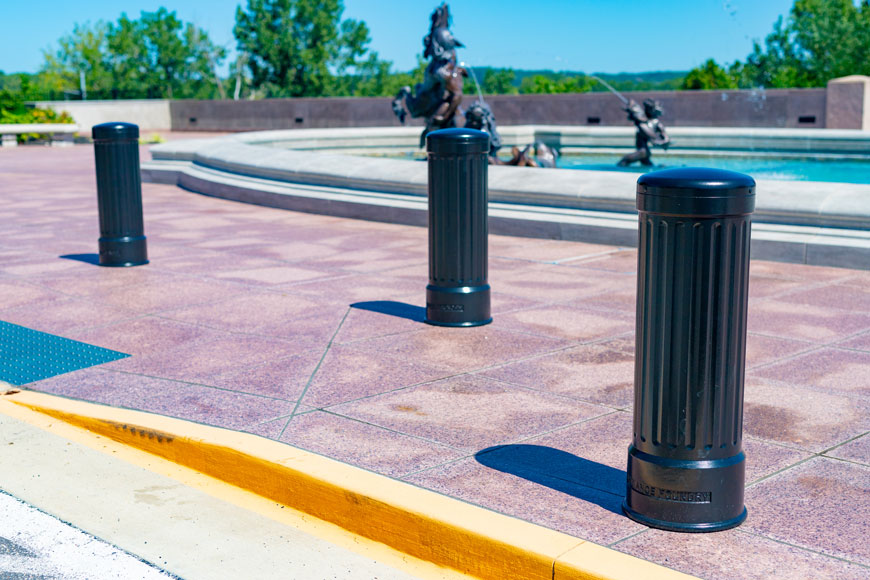The Main Principles Of Wedge Barriers
Wiki Article
The 2-Minute Rule for Wedge Barriers


The spring rod 58 is paired to a cam(e. g., webcam 80 shown in FIG. 4) of the training device 50. The springs 60 disposed about the spring pole 58 are held in compression by springtime sustains 62, consisting of a taken care of springtime support 64. That is, the fixed spring support 64 is dealt with about the structure 14 et cetera of the bather 10.
The Wedge Barriers Ideas
g., springtime assistance 65 )may be dealt with to completion of the spring pole 58 to enable compression of the springtimes 60. As the springs 60 are compressed between the springtime sustains 62, the spring setting up 54 creates a you can find out more pressure acting upon the camera combined to the spring pole 58 in a direction 66. For instance, the continuing to be pressure put on the web cam to deploy the wedge plate 16 may be supplied by an electromechanical actuator 84 or various other actuator. The springtime assembly 54 and the actuator 84(e. g., electromechanical actuator)might run together to translate the camera and raise the wedge plate 16.
As mentioned over, the springtime setting up 54 applies a continuous force on the camera, while the electromechanical actuator might be controlled to apply a variable force on the cam, therefore allowing the training and lowering( i. e., releasing and withdrawing )of the wedge plate 16. In specific embodiments, the consistent force used by the springtime setting up 54 might be flexible. g., electromechanical actuator) is handicapped. As will be valued, the spring setting up 54 may be covered and shielded from debris or various other elements by a cover plate(e. g., cover plate 68 displayed in FIG. 4) that might be considerably flush with the elevated surface area 38 of the structure 14. As stated above, in the deployed setting, the wedge plate 16 serves to block gain access to or travel past the barrier 10. The obstacle 10(e. g., the wedge plate 16 )might obstruct pedestrians or lorries from accessing a property or pathway. As talked about above, the obstacle 10 is connected to the anchor 30 safeguarded within the structure 14,
front brackets 71. Because of this, the affiliation assemblies 72 might pivot and rotate to enable the collapse and extension of the linkage settings up 72 during retraction and implementation of the bather 10. The link settings up 72 reason activity of the wedge plate 16 to be restricted. As an example, if a car is traveling towards the released wedge plate 16(e. For example, in one circumstance, the security legs 86 might be extended duringupkeep of the obstacle 10. When the safety legs 86 are released, the security legs 86 support the weight of the wedge plate 16 versus the surface 12. Consequently, the training mechanism 50 may be deactivated, serviced, gotten rid of, replaced, and so forth. FIG. 5 is partial perspective view of a personification of the surface-mounted wedge-style barrier 10, highlighting the webcam 80 and the cam surfaces 82 of the training mechanism 50. Particularly, two webcam surfaces 82, which are referred to as reduced camera surfaces 83, are placed listed below the camera 80. The lower web cam surfaces 83 may be fixed to the surface 12 (e. For instance, the lower web cam surfaces 83 and the placing plate 85 might develop a single item that is safeguarded to the support 30 by bolts or various other mechanical bolts. Furthermore, two camera surfaces 82, which are described as top camera surfaces 87, are positioned over the camera 80 and paired to (e. In other personifications, interfering layers or plates might be positioned in between the surface area 12 and the lower camera surfaces 83 and/or the wedge plate 16 and the upper camera surface areas 87 As mentioned above, the camera 80 equates along the webcam surface areas 82 when the wedge plate 16 is raised from the pulled back placement to the released position. Furthermore, as mentioned above, the look at more info spring assembly 54 (see FIG. 3 )might provide a pressure acting upon the camera 80 in the instructions 102 using springtime rod 58, which might decrease the pressure the electromechanical actuator 84 is needed to relate to the cam 80 in order to activate and raise the wedge plate 16. 1 )to the released placement(see FIG. 4). As revealed, the web cam 80 consists of track wheels 104(e. g., rollers), which get in touch with and convert along the web cam surface areas 82 throughout operation.
Report this wiki page